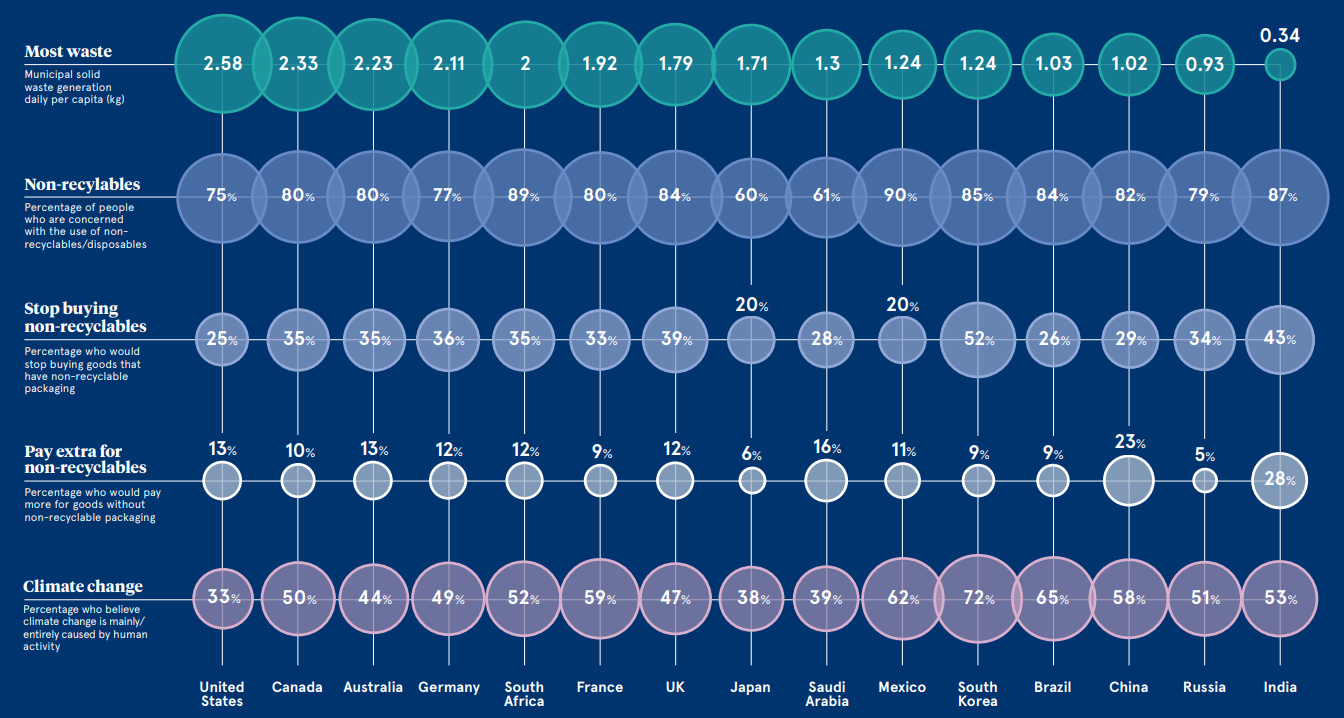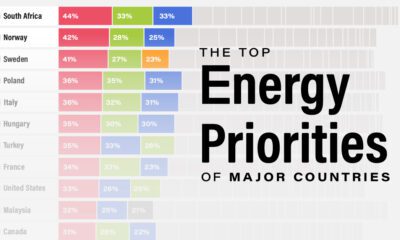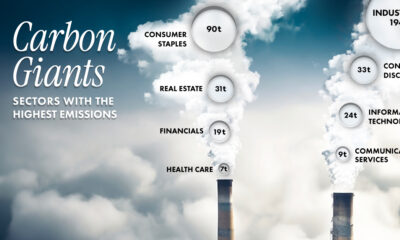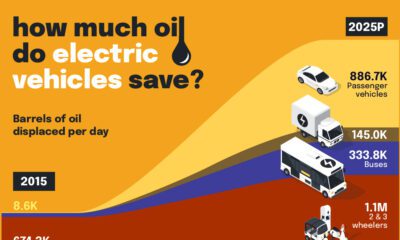Green
Visualizing What the World Thinks About Waste
View the full-size infographic by clicking here
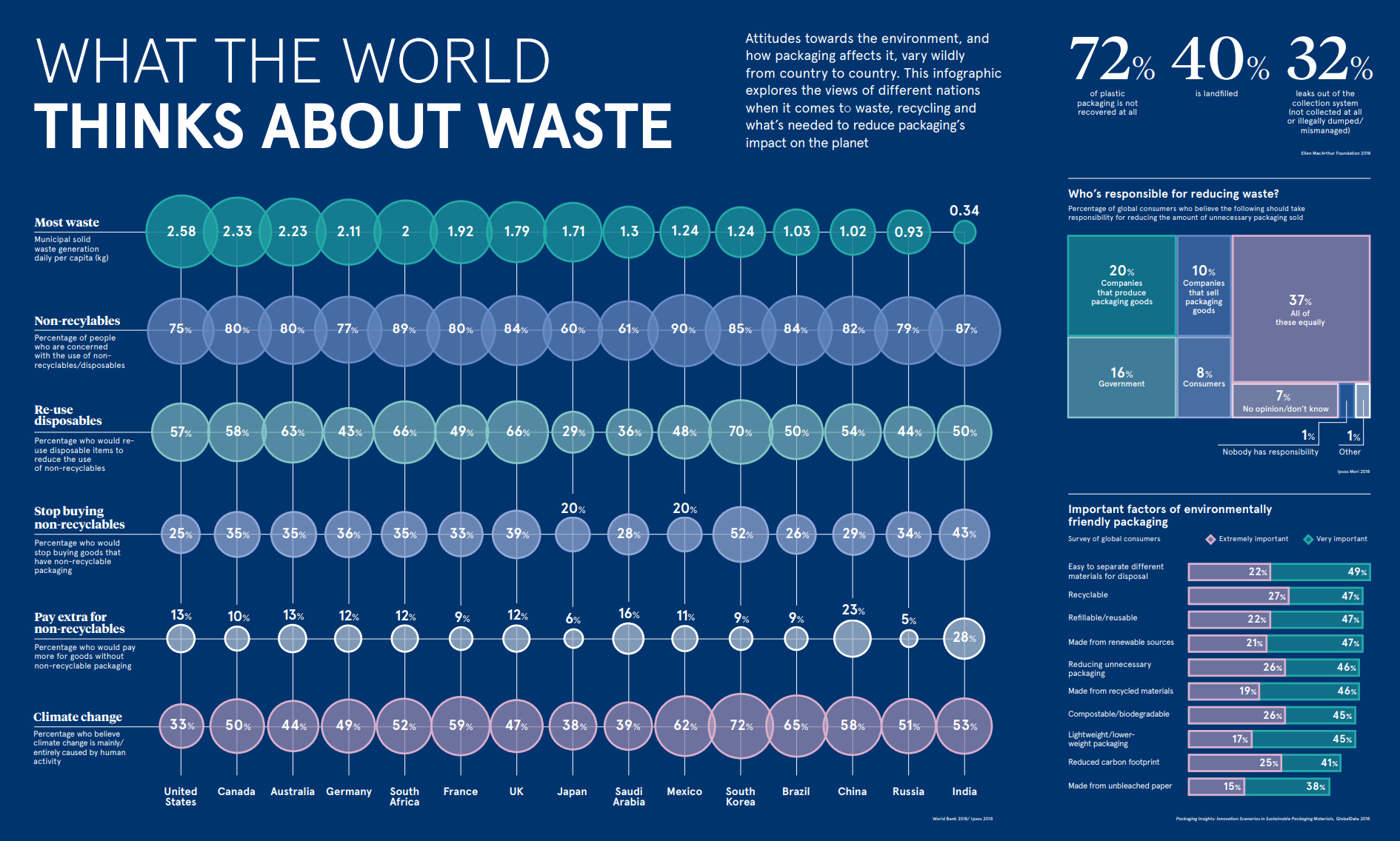
Visualizing What the World Thinks About Waste
See the high resolution of this graphic by clicking here for best viewing.
Waste is a seemingly inseparable part of modern life.
In every industrialized society, humans consume many goods ranging from fresh food to automobiles. Inevitably, the majority of these goods are associated with waste that ends up clogging up our landfills, recycling systems, or even our oceans.
While garbage is widely universal, our perceptions on it vary from culture to culture – and when it comes to thinking about the future of our planet, these differences are important to think about.
Waste by Country
Today’s infographic comes to us from Raconteur, and it shows global attitudes towards waste, recycling, and the environment.
Using data from select countries, here is the amount of solid waste created per capita on a daily basis:
| Country | Daily Solid Waste (per capita) |
|---|---|
| United States | 2.58 kg |
| Canada | 2.33 kg |
| Australia | 2.23 kg |
| Germany | 2.11 kg |
| United Kingdom | 1.79 kg |
| Japan | 1.71 kg |
| Mexico | 1.24 kg |
| China | 1.02 kg |
| India | 0.34 kg |
The U.S. leads the way in waste, but Western countries like Canada, Germany, and Australia are not far behind.
In India and China, waste numbers are low per capita right now, but they will continue to creep closer to Western figures as their economies further urbanize and increase consumption.
Global Attitudes Towards Waste
About 72% of plastic packaging does not get recovered at all, with 40% of all waste going to the landfill and 32% leaking out of the collection system (not collected, illegally dumped, or mismanaged).
With this in mind, who is responsible for reducing plastic packaging?
- 20% of global respondents say that the companies producing packaged goods should be responsible
- 16% say the government should be responsible
- 10% say the companies selling packaged goods should be responsible
- 8% say consumers
- 37% say all the above are equally responsible
- 9% say other, including having no opinion or being undecided
Interestingly, looking at individual countries reveals different perceptions than broader, global norms.
Attitudes Differ by Country
The infographic highlights the specific differences in attitudes towards waste between a multitude of countries.
While one expects big differences between countries like China and Germany, it can be shown that opinions on waste vary even between geographically proximate countries with similar levels of economic development. In South Korea and Japan, for example, waste attitudes differ considerably.
Per person, Japan produces 1.71 kg of solid waste per day, about 38% more than South Korea (1.24 kg).
South Koreans are more worried about the use of non-recyclable packaging, with 85% of people expressing concern about the issue. Roughly 60% of Japanese people felt the same.
To address this issue, 52% of Koreans said that they are willing to stop buying goods that have non-recyclable packaging – and only 20% in Japan concurred.
Even views of something broader like climate change differ between the two countries. In Japan, 38% of the population sees climate change as being caused by human activity, while 72% of Koreans see climate change the same way.
Green
The Carbon Footprint of Major Travel Methods
Going on a cruise ship and flying domestically are the most carbon-intensive travel methods.

The Carbon Footprint of Major Travel Methods
This was originally posted on our Voronoi app. Download the app for free on iOS or Android and discover incredible data-driven charts from a variety of trusted sources.
Did you know that transport accounts for nearly one-quarter of global energy-related carbon dioxide (CO₂) emissions?
This graphic illustrates the carbon footprints of major travel methods measured in grams of carbon dioxide equivalent (CO₂e) emitted per person to travel one kilometer. This includes both CO₂ and other greenhouse gases.
Data is sourced from Our World in Data, the UK Government’s Department for Energy Security and Net Zero, and The International Council on Clean Transportation, as of December 2022.
These figures should be interpreted as approximations, rather than exact numbers. There are many variables at play that determine the actual carbon footprint in any individual case, including vehicle type or model, occupancy, energy mix, and even weather.
Cruise Ships are the Most Carbon-Intensive Travel Method
According to these estimates, taking a cruise ship, flying domestically, and driving alone are some of the most carbon-intensive travel methods.
Cruise ships typically use heavy fuel oil, which is high in carbon content. The average cruise ship weighs between 70,000 to 180,000 metric tons, meaning they require large engines to get moving.
These massive vessels must also generate power for onboard amenities such as lighting, air conditioning, and entertainment systems.
Short-haul flights are also considered carbon-intensive due to the significant amount of fuel consumed during initial takeoff and climbing altitude, relative to a lower amount of cruising.
| Transportation method | CO₂ equivalent emissions per passenger km |
|---|---|
| Cruise Ship | 250 |
| Short-haul flight (i.e. within a U.S. state or European country) | 246 |
| Diesel car | 171 |
| Gas car | 170 |
| Medium-haul flight (i.e. international travel within Europe, or between U.S. states) | 151 |
| Long-haul flight (over 3,700 km, about the distance from LA to NY) | 147 |
| Motorbike | 113 |
| Bus (average) | 96 |
| Plug-in hybrid | 68 |
| Electric car | 47 |
| National rail | 35 |
| Tram | 28 |
| London Underground | 27 |
| Ferry (foot passenger) | 19 |
| Eurostar (International rail) | 4.5 |
Are EVs Greener?
Many experts agree that EVs produce a lower carbon footprint over time versus traditional internal combustion engine (ICE) vehicles.
However, the batteries in electric vehicles charge on the power that comes straight off the electrical grid—which in many places may be powered by fossil fuels. For that reason, the carbon footprint of an EV will depend largely on the blend of electricity sources used for charging.
There are also questions about how energy-intensive it is to build EVs compared to a comparable ICE vehicle.
-

 Debt1 week ago
Debt1 week agoHow Debt-to-GDP Ratios Have Changed Since 2000
-

 Markets2 weeks ago
Markets2 weeks agoRanked: The World’s Top Flight Routes, by Revenue
-

 Countries2 weeks ago
Countries2 weeks agoPopulation Projections: The World’s 6 Largest Countries in 2075
-

 Markets2 weeks ago
Markets2 weeks agoThe Top 10 States by Real GDP Growth in 2023
-

 Demographics2 weeks ago
Demographics2 weeks agoThe Smallest Gender Wage Gaps in OECD Countries
-

 United States2 weeks ago
United States2 weeks agoWhere U.S. Inflation Hit the Hardest in March 2024
-

 Green2 weeks ago
Green2 weeks agoTop Countries By Forest Growth Since 2001
-

 United States2 weeks ago
United States2 weeks agoRanked: The Largest U.S. Corporations by Number of Employees

